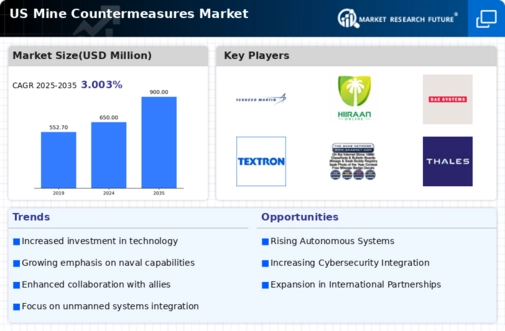The US Mine Countermeasures Market has evolved significantly over the years, gaining attention due to the increasing need for capable systems designed to detect, neutralize, and manage underwater threats. The competitive landscape is characterized by a blend of established defense giants and emerging technology innovators, each contributing unique capabilities to address these complex challenges. Factors such as geopolitical tensions, advancements in sensor technology, and increased funding for naval operations have amplified market activities, prompting companies to invest heavily in research and development.
Collaborations and partnerships with governmental defense agencies have further strengthened market positioning, underscoring the competitive nature of this critical defense sector.Raytheon Technologies has solidified its presence in the US Mine Countermeasures Market by leveraging its extensive experience in defense and aerospace technology. The company boasts significant strengths in developing advanced sensor systems, unmanned maritime vehicles, and integrated solutions that enhance mine detection and neutralization. With an emphasis on innovation, Raytheon invests heavily in R&D to create cutting-edge technologies that address current and future operational needs of the US Navy and allied forces.
The company's robust supply chain and strong relationships with government entities also position it advantageously within the market, allowing for timely deployment of effective countermeasures.Daheng New Epoch Technology operates within the US Mine Countermeasures Market focusing on technology-driven solutions that enhance mine detection and management capabilities. The company's key products include advanced imaging and sensing systems that utilize state-of-the-art technologies for underwater surveillance. In recent years, Daheng has made strides to increase its market presence by engaging in strategic partnerships and collaborations aimed at bolstering its technological offerings.
The company has also been involved in various mergers and acquisitions that enhance its resource capabilities, improving its product range. With a commitment to innovation and quality, Daheng New Epoch Technology plays a significant role in shaping the competitive dynamics of the US Mine Countermeasures Market, contributing to ongoing advancements in maritime security solutions.



















